
Saturday 29 April 2023
Macro Greens

Thursday 27 April 2023
Willow on the go
The willow arch in the school garden is up and running with a flush of green leaves. So reassuring to know it must have put down roots. And the dome next to it isn't doing badly either!
Friday 14 April 2023
Spring Beauty - Claytonia perfoliata
Friday 7 April 2023
Sunday 2 April 2023
It's All Kicking Off
The broadbeans were looking strong before and after planting out.
The potato variety is Epicure. We like floury potatoes and these fit the bill. Also they are about the hardiest potato variety known to me and will shrug off any frost damage. (Famous last words)
Saturday 1 April 2023
Parsimonious with Parsnips
Parsnips are one of the first seeds you can sow direct out of doors. They are notoriously slow to germinate and also slow to reach maturity. The slow germination means that by the time you notice they have failed it is too late to sow again - unless you are monitoring them very closely and keeping the weeds from overtaking them. One suggested solution is to sow radishes and parsnips together. In theory the quick growing radishes mark out the row and are harvested well in advance of the parsnips which then grow on without competition. I have not tried this as radishes are brutes and their harvesting would necessarily disturb the parsnip roots in the process. Another strategy, which I have tried, is to sow groups of three parsnips at regular spacings along the row. This has the advantage of providing an expected pattern to look out for amidst the germinating weeds. The only problem is when none out of three germinate.
A renown feature of parsnip seed is its short viability. Many old hands advise that you need to buy new seed each year. Seed suppliers are generous with the quantity (800 in the packet above). 20 well grown parsnips is more than enough for me. It is a good idea to share your parsnip seed with your neighbours.
These considerations explain my interest in the "fluid sowing" method suggested by David Gray in Know & Grow Vegetables (1979). The idea is that you pregerminate your parsnip seeds before adding them to wallpaper paste which is piped into drills. (Given that commercial wallpaper pastes all have fungicide in them I use cornflour paste). In theory, using this method, you know that your seeds are viable and have germinated. You can also sow accurately to a desired density (by spreading the paste with the given number of seeds along a given length of drill).
Today I have wetted the seeds. By next weekend I hope they will be ready for deployment outdoors.
footnote: I did try this system two years ago but the whole project failed when a well meaning neighbour deposited a barrel on the bed which repeatedly rolled back and forth across the bed during a windy weather before I discovered it. Last year I sowed conventionally, three times, and still failed to produce parsnips bigger than carrots.











